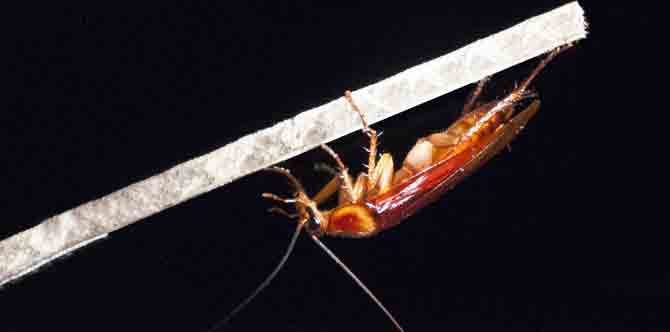Science News
Cockroach on a Ledge
June 11, 2012

Robert Full is obsessed with how nature moves. At his Poly-PEDAL Laboratory at UC Berkeley, researchers put animals through their paces to determine how they walk, run, leap and maneuver.
Among their subjects are geckos and cockroaches. “Cockroaches continue to surprise us,” says Full, a professor of integrative biology who 15 years ago discovered that when cockroaches run rapidly, they rear up on their two hind legs like bipedal humans. “They have fast relay systems that allow them to dart away quickly in response to light or motion at speeds up to 50 body lengths per second, which is equivalent to a couple hundred miles per hour, if you scale up to the size of humans. This makes them incredibly good at escaping predators.”
Besides their speed to evade predators, cockroaches are also able to flip under ledges and disappear in the blink of an eye, the UC Berkeley researchers report recently in PLoS ONE. The cockroach does this by grabbing the edge with grappling hook-like claws on its back legs and swinging like a pendulum 180 degrees to land firmly underneath, upside down.
This pendulum swing subjects the animal to 3-5 times the force of gravity (3-5 gs), similar to what humans feel at the bottom of a bungee jump, lead author Jean-Michel Mongeau says.
(Video of the feat is available here.)
Surprisingly, the researchers observed geckos using this same escape technique both in the lab and in the rain forest at the Wildlife Reserves near Singapore.
“This behavior is probably pretty widespread, because it is an effective way to quickly move out of sight for small animals,” Full says.
Full and his colleagues make good with these obsessions with animal movements. They use the mechanics found in nature for robotics. Nature has had millions of years to develop the engineering, so why not borrow it?
“This work is a great example of the amazing maneuverability of animals, and how understanding the physical principles used by nature can inspire design of agile robots,” UC Berkeley engineering professor Ron Fearing says.
With the help of Poly-PEDAL Lab’s observations, Fearing’s team created a robot that can turn onto ledges like the roaches and geckos.
This new robot could help in dangerous search and rescue missions, according to Full. “That's really the challenge now in robotics: to produce robots that can transition on complex surfaces and get into dangerous areas that first responders can't get into.”
Photo by Jean-Michel Mongeau and Pauline Jennings, courtesy of PolyPEDAL Lab, UC Berkeley